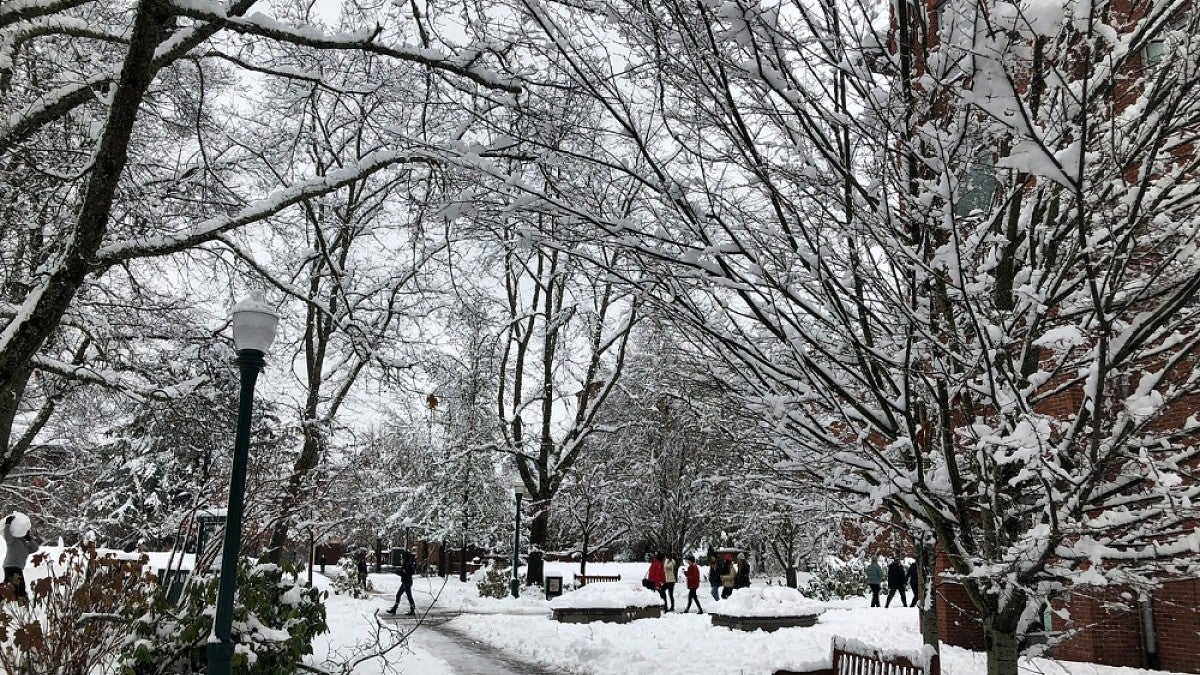University of Oregon employees and students need to be ready for hazardous weather anytime from November through March. Although UO operations are predominantly remote, some in-person instruction is planned on campus during the winter term and some faculty members, officers of administration and classified employees are working in person to support research activities and to provide necessary services to students and the university community. Recognizing that inclement winter weather could impact university classes, research and other operations, the UO community should understand how closure and delay decisions are made and how information about inclement weather is shared.
As a research and residential campus, the UO rarely closes and has many functions that go on regardless of weather. UO policy allows for a delayed opening, early closure or full closure when the UO’s incident management team and administrators determine that campus is not safe, or when local conditions are extremely severe. Regardless, some research, facilities and housing operations will always operate. Employees who perform essential functions will be expected to work if they can do so safely. Employees who aren’t sure if their functions are designated as essential should ask their supervisors.
Under the UO’s comprehensive weather monitoring and decision-making protocol, Safety and Risk Services staff work with the National Weather Service to get early weather warnings. The UO’s incident management team monitors local conditions and checks with other local agencies such as the cities of Eugene and Springfield, Lane Transit District, the Oregon Department of Transportation and local school districts.
Campus staff also check road and path conditions and report to the incident management team, whose leaders convene with UO administrators to decide whether a delayed opening, early closure or full closure is necessary.
The open hours and status of campus facilities continue to be adjusted as part of the university’s COVID-19 response and modified operations. Implications of inclement weather on building access will be considered in the same manner. The UO building status map provides the latest information about building access even during periods of inclement weather.
The clearing of walkways and tending to outside areas impacted by winter weather will be prioritized by building access status. The areas of campus with more in-person activity will be of primary focus. If someone must be on campus during winter weather events, they should do so with caution and practice winter weather safety.
Members of the campus community are expected to use their best judgment in assessing the risk of coming to campus, based on individual circumstances and in consultation with supervisors or instructors. UO leaders ask instructors and supervisors to be flexible in working with people who choose not to come for their own safety.
Due to the UO’s predominantly remote operations, faculty and staff may be uniquely impacted by winter weather occurring in the location of their remote workspace. Supervisors and employees should discuss contingency plans and communication expectations in advance of an anticipated weather event. Refer to the HR website for further guidance.
The UO suggests several tools employees and students can use to be aware, prepared and resilient in hazardous weather:
- UO Alerts: Official communication of any changes to the university’s schedule comes through UO Alerts texts and emails. All employees and students should make sure current mobile numbers are activated to receive UO Alerts text messages in all emergencies, including weather situations. Manage UO Alerts at duckweb.uoregon.edu. Emails come to all uoregon.edu accounts.
- UO Alerts blog: Includes all UO Alerts messages but also shares extra information on known hazards and resources for safety and information. The best UO source for ongoing and detailed information.
- UO inclement weather route map.
- Human resources: A web page on inclement weather explains how employees may be paid or use leave depending on institutional status, employee classification or individual decisions.
- UO policy on closure of facilities and operations.
- Winter tips: The right clothing, footwear and even tactics for walking can be the difference between safety and serious injuries.
- Winter driving tips and resources from the Oregon Department of Transportation and National Weather Service.


